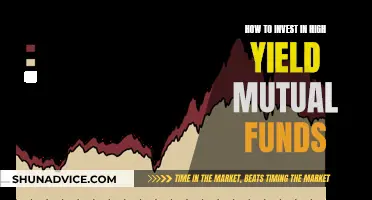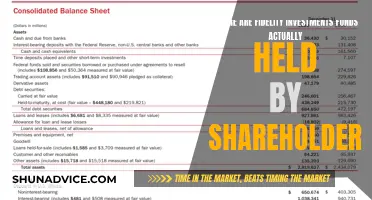
Mutual funds are a type of investment product where the funds of many investors are pooled and used to invest in a group of assets. There are thousands of mutual funds available, so how do you choose the right one for you?
Firstly, it's important to identify your goals for the investment. Are you investing for retirement, a house down payment, or your child's education? You should also consider your risk tolerance and how much risk you are willing to take on.
Next, you should decide whether you want an actively or passively managed fund. Actively managed funds have portfolio managers who research and decide which securities and assets to include in the fund, whereas passively managed funds, or index funds, seek to track and duplicate the performance of a benchmark index.
You should also research the fund's past performance and the fund manager's track record. Check the fund's historical performance and whether it typically beats its benchmark.
Another important factor is fees. Mutual funds can have front-end or back-end load fees, which are charged when you buy or sell shares, as well as expense ratios, which are charged annually as a percentage of assets under management.
Finally, don't forget to diversify your portfolio by investing in different asset classes such as stocks, bonds, and international funds.
| Characteristics | Values |
|---|---|
| Investment objective | Long-term capital gains, current income, college expenses, retirement |
| Risk tolerance | Volatility, beta, fund manager performance, risk appetite |
| Investment horizon | Short-term, medium-term, long-term |
| Investment strategy | Growth, dividend, index, passive, active |
| Fund performance | Consistency, stability, benchmark comparison |
| Expense ratio | Annual fee, management fee, distribution fee |
| Exit load | Fee charged when selling units of the mutual fund |
| Tax implications | Taxed on income and capital gains |
| Direct plans | No intermediary, lower expense ratio |

Risk tolerance
Understanding Your Risk Tolerance
Before investing in mutual funds, it is important to evaluate your personal risk tolerance. Ask yourself whether you can tolerate dramatic swings in your portfolio's value or if you prefer a more conservative approach. Are you comfortable with taking on higher risks for potentially greater returns, or do you prioritize capital preservation? Your risk tolerance will guide you in selecting the right type of mutual fund that aligns with your comfort level.
Assessing Risk in Different Mutual Funds
Different types of mutual funds carry varying levels of risk. Equity mutual funds, for example, tend to have higher risk and volatility but offer the potential for higher returns. In contrast, debt mutual funds are considered more stable and conservative, with lower returns. Small-cap funds are generally riskier than large-cap funds. Additionally, growth and capital appreciation funds, which focus on common stocks, are riskier but offer higher returns over time. Income funds, which invest in bonds and debt instruments, are usually less risky and provide regular income.
Aligning Risk Tolerance with Investment Goals
When considering risk tolerance, it's essential to align it with your investment goals and time horizon. If you need access to your money within a short period (less than five years), an aggressive growth fund is typically not suitable. Target-date funds are a good option in such cases, as they adjust their risk level based on your proximity to retirement age. If you have a long time horizon and a high risk tolerance, all-stock mutual funds may be appropriate. On the other hand, if you seek a degree of safety, consider funds with exposure to bonds or other fixed-income investments.
Risk and Return Relationship
It's important to understand the direct relationship between risk and return. Higher risks are often associated with the potential for greater returns, while lower risks may result in more modest returns. When assessing your risk tolerance, consider your desire for returns against your ability to tolerate the risks involved. Remember that past performance doesn't guarantee future results, so conduct thorough research and consult a financial advisor if needed.
Risk Mitigation through Diversification
Diversifying your portfolio is a crucial strategy to manage risk effectively. By investing in various asset classes, such as stocks, bonds, international funds, real estate, and fixed-income funds, you can reduce the overall volatility of your portfolio. Diversification helps protect your investments during industry-specific or market-wide downturns. It ensures that your portfolio is well-rounded and better positioned to weather different economic conditions.
Index Funds vs Roth IRA: Where Should You Invest?
You may want to see also

Investment goals
Before investing in mutual funds, it is crucial to identify your investment goals and risk tolerance. Ask yourself: what is the purpose of this investment? Is it to purchase a property, finance your child's education, save for retirement, or fund a dream vacation? These goals will guide you in selecting the most suitable mutual fund.
Different mutual fund categories cater to diverse goals and timeframes. For instance, equity funds are typically recommended for long-term aspirations beyond five years, as they have the potential for higher returns. In contrast, debt funds are more suitable for shorter horizons, ranging from one day to five years, as they offer lower risk. Hybrid or balanced funds provide a middle ground by combining equity and debt components, making them appropriate for investors seeking moderate risk.
Additionally, consider your risk tolerance. Are you comfortable with dramatic swings in portfolio value, or do you prefer a more conservative approach? Remember that risk and return are directly proportional, so balance your desire for returns with your ability to tolerate risk.
Finally, determine the desired time horizon for your investment. How long do you plan to hold the investment? Are there any liquidity concerns or near-future financial goals that need to be addressed? To mitigate the impact of sales charges, an investment horizon of at least five years is generally recommended.
By clearly defining your investment goals, risk tolerance, and time horizon, you can make more informed decisions when selecting mutual funds that align with your objectives and financial profile.
Dimensional Fund Investing: What Products Are Offered?
You may want to see also

Fund management style
When it comes to mutual fund investments, it is important to understand the fund's management style and whether it aligns with your investment goals and risk tolerance. Here are some detailed paragraphs on this topic:
Active vs Passive Management
The first key distinction in fund management styles lies in whether the fund is actively or passively managed. Actively managed funds have portfolio managers who actively research, analyse and make decisions on which securities and assets to include in the fund. They consider factors such as company fundamentals, economic trends, and macroeconomic factors. Active funds aim to outperform a benchmark index, and fees tend to be higher.
On the other hand, passively managed funds, often called index funds, aim to replicate the performance of a benchmark index. They have lower fees and don't trade their assets very often. Passive funds may hold thousands of different securities, resulting in a highly diversified fund. The low fees and reduced taxable income of passive funds make them a popular choice.
Evaluating Fund Managers
When considering an actively managed fund, it is important to research the fund manager's track record. Ask questions such as: did the fund manager deliver results consistent with market returns? Was the fund more volatile than major indexes? Was there an unusually high turnover? These questions will give insight into how the fund manager performs and help illustrate the fund's historical trend in terms of turnover and return.
Past Performance
While past performance doesn't guarantee future results, it is still a useful indicator of a fund's potential. Check the fund's historical performance and whether it typically beats its benchmark. Also, consider the consistency of returns—a fund that delivers consistent returns is often better than one with sporadic high and low returns.
Fees and Expenses
The fees and expenses of a mutual fund can significantly impact your investment returns. Active funds tend to have higher fees to compensate fund managers for their time, while passive funds have lower fees. There are various types of fees to look out for, including front-end and back-end load fees, expense ratios, management fees, and distribution fees. These fees can add up over time, reducing your overall returns.
Volatility and Risk
Different mutual funds have different levels of risk and volatility. It is important to understand your own risk tolerance and choose a fund that aligns with your comfort level. Active funds, particularly those focused on growth and capital appreciation, tend to be riskier, while income funds that invest in bonds and debt instruments are more conservative.
In summary, when considering mutual fund investments, thoroughly research the fund's management style. Evaluate whether active or passive management suits your goals, analyse the fund manager's performance, consider past returns and volatility, and carefully review all fees and expenses.
Mutual Fund Investment Strategies: Where to Invest?
You may want to see also

Fund performance
Evaluating Fund Performance
When assessing the performance of a mutual fund, it is essential to look beyond short-term returns and focus on long-term, consistent, and stable returns. Compare the fund's performance with relevant benchmarks and its peer group. Consider factors such as volatility and turnover, as high turnover can create taxable events that impact your returns. Additionally, evaluate the fund's historical performance to gain insights into its trend in terms of returns and volatility. Remember that past performance does not guarantee future results, but it can provide valuable context.
Role of Fund Managers
The fund manager plays a crucial role in the performance of a mutual fund. Evaluate the fund manager's track record and experience. Assess whether the fund manager has delivered results consistent with market returns and whether their investment strategy aligns with your goals. A strong, stable, and experienced fund management team with a proven track record can be beneficial for investors.
Performance Consistency
Consistency in fund performance is a hallmark of good funds. A fund that delivers consistent returns, even if slightly lower than market-leading funds, can provide better long-term results. Consistent returns help control losses and increase your chances of earning good returns over time. For example, if a fund experiences a 5% loss in a year, it will need to generate an 11% return to break even and provide you with a 5% return. Therefore, consistency is key when evaluating fund performance.
Time Horizon and Risk Tolerance
Your time horizon and risk tolerance play a significant role in fund selection. If you have a long-term investment horizon and a high-risk tolerance, you may opt for all-stock mutual funds, which historically offer higher returns. On the other hand, if you seek a degree of safety, consider mutual funds with exposure to bonds or other fixed-income investments. Remember that different mutual fund categories have different performance dynamics over distinct time frames.
Expense Ratios and Fees
Expense ratios and fees can significantly impact your investment returns. Compare the expense ratios of different funds, as these fees reduce your net return. No-load funds, which do not charge a load fee, may have very high expense ratios. Additionally, consider other fees such as front-end and back-end load fees, which are charged when buying or selling shares, respectively. Mutual funds with high fees can eat into your returns, so it is essential to factor them into your decision-making process.
ETFs and Mutual Funds: Key Investment Considerations
You may want to see also

Fund fees
It is worth noting that the expense ratio is derived from the AUM, and it is believed that higher AUM leads to a lower expense ratio. According to a recent report, the average expense ratio for actively managed funds was 0.68% in 2021, while for index funds, it was 0.06%. While these numbers may seem small, they can cost tens of thousands of dollars over an investor's lifetime when compounded.
In addition to the expense ratio, there are other fees associated with mutual funds that investors should be aware of. Some funds charge a sales fee called a load, which can be front-end or back-end. Front-end load fees are paid when purchasing shares, while back-end load fees are charged when selling shares, typically before a set time period such as five to ten years from the purchase date. These load fees can range from 3% to 6% of the total amount invested or distributed, but by law, they cannot exceed 8.5%.
No-load funds, on the other hand, do not charge a load fee. However, they may have other fees, such as the management expense ratio, which can be very high. Additionally, some funds charge 12b-1 fees, which are included in the share price and used for promotions, sales, and other distribution-related activities. These fees can be up to 1% of the investment, and investors may not always be aware of them.
When considering fund fees, it is also essential to look at the management expense ratio, which can help clarify any confusion relating to sales charges. Passive or index funds generally have lower fees than actively managed funds, as they do not trade their assets very often and have lower turnover, resulting in reduced costs for the fund. According to 2022 data, the average expense ratio for an actively managed equity fund was 0.66%, while for passively managed funds, it was 0.05%.
In summary, investors should be mindful of the various fees associated with mutual funds, as they can significantly impact investment returns. By choosing funds with lower expense ratios and being aware of load fees and other charges, investors can maximize their returns and make more informed investment decisions.
Private Equity Funds: Impact Investing Strategies Revealed
You may want to see also
Frequently asked questions
There are several factors to consider, including your investment goals, risk tolerance, time horizon, and investment strategy. You should also research the fund's management style, past performance, fees, and tax implications.
Each mutual fund category has a different level of risk. You can check the "riskometer" of a particular fund to understand the potential risks. It's important to consider your own risk tolerance and choose funds that align with your comfort level.
Actively managed funds have portfolio managers who actively research and select securities to include in the fund, aiming to outperform a benchmark index. Passively managed funds, or index funds, aim to track and duplicate the performance of a benchmark index and typically have lower fees.
Mutual funds may charge various fees, including load fees (charged when buying or selling shares), expense ratios (annual fees based on a percentage of assets under management), and management fees. It's important to consider the total fees as they can significantly impact your investment returns.







